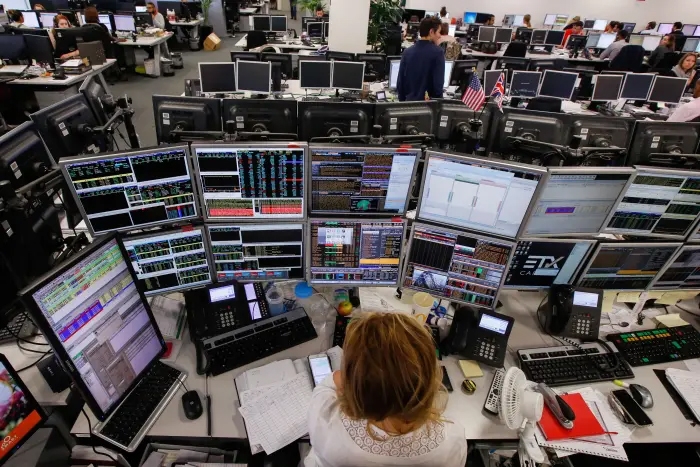
Investors are rolling out the excuses to sell risk assets as the new week begins, with chunky falls across global equities, a shift to the safety of government bonds, and safe-haven currencies outperforming.
After three consecutive weekly falls in the S&P500, the odds would currently favour a fourth negative week ahead, with the index down some 2½% as the new week begins. Unlike previous sessions, this selloff hasn’t been tech-led, with the Nasdaq index showing a more moderate fall. European equities are much weaker, with the Euro Stoxx 600 index closing down 3.2%.
The sell-off reflects broadly weaker risk sentiment, with a number of concerns cited, ranging from a deterioration in trends in COVID-19 case numbers with the associated threat of more lockdowns, a report on the banking sector that showed some major global banks’ lax response to anti-money laundering warning signs, and the upcoming US elections, with the death of Justice Ginsburg adding another layer of risk.
On COVID-19, Germany’s Health Minister called the recent increase in daily cases there and in other European nations as “worrying”. In the UK, there are fears that the country is heading for further economically-punishing restrictions, as new case numbers explode higher, with the current rate of new infections doubling every seven days.
In the US, the 7-day moving average of new COVID-19 case numbers reached close to 40k, higher than the 14-day average, a sign of recently rising numbers. A US health expert, former FDA commissioner Gottlieb told media that he thought there would be at least one more cycle with the virus, “…if you look at what’s happening around the country right now, there’s an unmistakable spike in new infections”.
Hitting some financial stocks, the International Consortium of Investigative Journalists detailed more than $2tn in transactions between 1999 and 2017 that were flagged by global banks’ internal compliance officers as possible money laundering or other criminal activity, but the global banks “kept profiting from powerful and dangerous players”. The report raised the spectre of another round of punitive fines for banks at the centre of the investigation, who continued their behaviour even after the US had imposed penalties on the banks for such lax controls.
And the death of the US Supreme Court’s Justice Ginsburg, adds another layer of risk to the upcoming US elections due to the contentious nature of any new appointment and the selection process. Media, such as the WSJ, suggest that the “campaign agenda will ramp up interest in the election among activists on both the left and the right, for whom the future of the Supreme Court and its role in shaping American culture is already of high importance.” President Trump has said that he wants a replacement for Ginsburg confirmed before the November election. Without a replacement, there is potential for a 4-4 deadlock should the Supreme Court be required to adjudicate a disputed Presidential election result.
The switch out of equities sees global bond markets well bid, with key European 10-year government yields down 3-4bps and the US 10-year Treasury yield down 3bps to 0.66%.
Safe haven currencies have outperformed, with the USD, JPY and CHF heading the leaderboard. The USD has been the best of the lot, with the BBDXY index up 0.7% for the day. EUR and GBP are both down 0.7% and 0.9% respectively to 1.1750 and 1.2795. The NZD has been the worst performer, down 1.4% to 0.6660, retracting some of last week’s undeserving outperformance which we had put down to speculative flows, namely the closing of short NZD/AUD positions. The AUD is down just over 1% to 0.7210.
So the NZD is weaker on all the crosses, with NZD/AUD down to 0.9240 and NZD/JPY down more than 1.2% to be back below the 70 mark.
The domestic rates market was quiet yesterday, with yields some 1-2bps lower across the government and swap curves. Government rates with 3-5 years maturity are all now well embedded in negative territory, with the 5-year rate closing at minus 0.04%. The 10-year rate (2031) closed at a record low of 0.52%. The RBNZ will be pleased with the lower yield curve as it drafts up its next policy statement, due tomorrow.
In the day ahead a number of central bankers will be speaking. In terms of the highlights, this afternoon RBA Deputy Governor Debelle talks on the Australian economy and monetary policy, and will have the opportunity to lend weight to the view that the RBA is open to more monetary stimulus to meet its objectives. Fed Chair Powell will be grilled tonight in front of a House panel where he will be defending the Fed’s policy stance of low rates for an extended period and a bloated balance sheet.

We welcome your comments below. If you are not already registered, please register to comment
Remember we welcome robust, respectful and insightful debate. We don't welcome abusive or defamatory comments and will de-register those repeatedly making such comments. Our current comment policy is here.